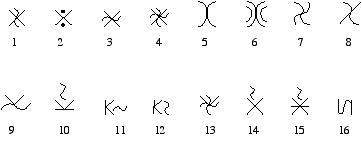Topics: Flexion, bending/folding - unspecified amount
The following comments were excerpted from notes taken at an informal in-house theory meeting that took place at the Dance Notation Bureau in June 1999. Present at this discussion were: Ann Hutchinson Guest, Ilene Fox, Sandra Aberkalns, Ray Cook, Robin Hoffman, and Charlotte Wile.
For several years now, notators at the DNB have been trying to find a symbol for flexion and another for bending/folding that is unspecified in terms of the amount. For folding/bending there is the additional challenge of describing a fold/bend happening in a specific direction.
Below is the unedited discussion (i.e. the various ideas that were presented for consideration).
The discussion then progressed to the DNB's need to describe contraction and flexion/bending in general terms. Some of the symbols have been discussed at past ICKL conferences, others are from Knust. Individuals present at the meeting shared what they have been using in scores and suggested ideas for other symbols that could be used in general statements. At the end of the discussion there is a Topic Summary, as there was a consensus on a possible solution.
1. Any degree of flexion. Placing an ad lib through "X" so it passes through where indications for degree are usually placed was suggested.
2. Three degree contraction.
3. The sign for the basic movement of flexion, includes the sign for "any", thus giving complete freedom as to which form of flexion may be used (Your Move p. 76).
4. Any form of flexion, any degree. No one likes this one as it is much too difficult to read. While this may have been used/tried in the past, AHG suggests that any further use be discouraged.
5. Any degree of contraction. Trying to separate concept of body flexion from space measurement. Currently being used by some notators (and glossarized).
6. While the notes from the June 8, 1998 minutes are incomplete, and vague, this topic was discussed. The word note accompanying the symbol seen in number 5 indicates that AHG viewed this symbol as "physically a slight bending". Fox then recommended an ad lib that was doubled. This was difficult to read and may have mutated into number 6.
7. Cook has used this in scores to indicate any degree (and glossarized).
8. See number 7. Variation on the theme (not used by Cook). Written by group just to see an alternate way of writing.
9. Labanotation p. 327. Unspecified folding. Direction and amount are unspecified. Some notators have been glossarizing this symbol to mean that only the amount is unspecified and then are flipping the symbol to the appropriate side to indicate which surface is folding.
AHG, Fox, and Wile were concerned with notators manipulating a symbol that already has clearly defined usage even when glossarized, so the discussion centered on how to best manipulate the symbol to meet the notators needs.
10. Specifically folding over the forward surface an unspecified amount.
11. Specifically folding over the right surface an unspecified amount. Fox recommended that the reduced ad lib symbol be placed on the side of the fold where the first dot would normally go (which modifies the symbol to 2 degrees).
12. Same as number 11 with the ad lib written differently. Everyone agreed that writing the ad lib vertically or horizontally would be acceptable, with the decision left to the notator. But, it was also generally agreed that if the ad lib can be written at a right angle to the fold that would be the ideal. Therefore, on a diagonal fold the ad lib would also be angled.
13. Another writing option for number 11. Not to be confused with number 9.
14. Discussion then reopened on how to write ad lib amount of contraction. As an alternative to numbers 1, 5, 7, and 8, it was recommended to try the reduced ad lib within the symbol (again on the side where the first modifying dot would normally be placed).
15. Any degree of 3 dimensional contraction.
16. While not discussed, Cook said that he has used this symbol to indicate unspecified amount of extension.
The idea was then expanded to describe unspecified amount of angling with the following ideas as to how to best modify that symbol.
a. The idea to place the ad lib inside the symbol was a good idea but obviously did not work from a practical perspective.
b. This was thought to be a good idea, and can be used by the notator if there are space constraints, but...
c. To be consistent with the examples above (numbers 11-15) it was preferred by those present that the ad lib go on the side where the first dot would normally go.
d. Dot theory continued.
e. Any degree and direction of fold.
Topic Summary:
Everyone agreed that there should be an attempt to codify this usage, as it seems there is a need (rather than have every notator creating their own symbols).
Everyone agreed that the use of ad lib, where the 1st dot is usually placed, was not only functional, but the theory could be applied consistently with folding, contraction, and angling.
Everyone present at the DNB meeting agreed to use these new symbols (and glossarize) on a trial basis.
This discussion would make an ideal theory topic for ICKL, as it is applicable to LN, KIN, and Motif practitioners.





No comments:
Post a Comment